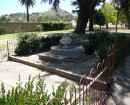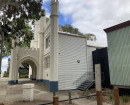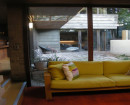FORMER GOVERNMENT CAMP PRECINCT (ROSALIND PARK)
PALL MALL AND VIEW STREET AND BARNARD ROAD AND PARK ROAD BENDIGO, GREATER BENDIGO CITY
-
Add to tour
You must log in to do that.
-
Share
-
Shortlist place
You must log in to do that.
- Download report













Statement of Significance
What is significant?
The area known as Rosalind Park was first mapped by Surveyor George Urquhart in 1852 and designated a Government Camp to serve the local goldfields. In 1856, Gold Commissioner Joseph Panton first mooted the idea of transforming the camp of makeshift buildings and reserve into a park, but instead more permanent government buildings were erected and Bendigo Creek was transformed into a channel. In May 1861, however, 59 acres of the land were reserved and handed over to the Sandhurst Borough Council. Work commenced immediately on improvements, and in 1862 George Brown was appointed first curator. It was during these years that the name Rosalind Park (a reference to the miniature park in Shakespeare's As You Like It) was first used. Development progressed in the 1870s with the addition of an ornamental fence and numerous new plantings, some from Ferdinand von Mueller. Curator, Samuel Gadd, who was appointed during these years, submitted plans showing a network of paths 10 feet in width, avenues planted with shady trees, and the parkland ornamented with choice specimen trees. In 1880 a large fernery was established on its present site, and a cascade was designed by local architect William Vahland. Consisting of statues, fountains and a vaulted grotto, the ambitious structure, which was filled-in some time this century, was partially re-instated in 1997. Three iron bridges were erected across the creek in 1882, with the Conservatory Gardens laid out in 1886 and a conservatory erected in 1897. Developments this century have included the erection of the poppet legs from the former Garden Gully Mining Company on the summit of Camp Hill in 1931, and a number of small community buildings which were removed following the recommendations of the 1995 Rosalind Park redevelopment plan.
How is it significant?
Rosalind Park is of historic, aesthetic, scientific, architectural and archaeological significanceto the State of Victoria.
Why is it significant?
The Former Government Camp Precinct (now Rosalind Park) is historically significant as the site of one of the largest government camps on Victoria's goldfields; the open parkland still allows the former camp site to be readily appreciated and the reconstructed poppet legs on Camp Hill preserve the original function of the hill as a lookout. The Park symbolises the "civilising" effect of gold and is a significant example of a large, late nineteenth century public recreation reserve. Features which enhance this quality include the interface with the surrounding nineteenth century streetscape, the close proximity of significant government buildings, and the rich overlay of different uses of the Park over many years. The stone-lined Bendigo Creek channel is historically significant for its strong association with gold mining in central Bendigo, and is an important example of late nineteenth century urban infrastructure development. The conservatory in Rosalind Park's Conservatory Gardens is historically significant as the State?s only surviving example of a nineteenth century conservatory in a public park.
Rosalind Park is archaeologically significant for its potential to demonstrate the occupation and use of the site relating to the government camp activities in particular to the gold mining. It is also significant as the known location of three burials of executed prisoners from the HM Prison between 1885 and 1897.
The Former Government Camp Precinct in Bendigo (now Rosalind Park) has the potential to demonstrate the occupation and use relating to the former Government Camp Precinct, through sub-surface features and artefacts - particularly in the years associated wit the gold rush in the mid-1800s.
Rosalind Park is aesthetically and scientifically (horticulturally) important for the retention of its nineteenth century layout, its significant plantings, some dating from the 1870s, its differing levels of horticultural intensity, the avenues of elms, oaks and palms, and fernery, including water features, bridges, rockeries, gravel paths, and a fern and palm collection . Aesthetically significant garden elements include the 2 ivy baskets in the Conservatory Gardens, 3 iron bridges over Bendigo Creek, the iron fencing and gates, the collection of statuary, and the original remnants of the cascade which are highly significant for forming the only known garden construction of this type in the State. Significant trees include; Umbellularia californica, the only known example in Victoria; Flindersia australis (only three in Victoria), Araucaria bidwillii (near the View Street entrance), Afrocarpus falcata; eight Washingtonia filifera (Conservatory Garden); Waterhousea floribunda (near the Queen Victoria statue); and Jubaea chilensis. Statuary which contributes to the aesthetic significance of the park includes; the white marble statue of Daphne (1871); the bronze sculpture of George V (1938); the white marble Venus (1901); the metal composition of man and animals (c.1899); the George Lansell Monument (after 1906); the James Curnow Memorial Fountain (n.d.); the Ernest Mueller Bust (c.1910); the Queen Victoria Monument (1903); the Nude with Snake (n.d.); and the Sir John Quick Bust (1934).
[Source: Victorian Heritage Register]
-
-
-
-
ANNE CAUDLE CENTRE, BENDIGO BENEVOLENT ASYLUM AND LYING-IN HOSPITAL
 Victorian Heritage Register H0992
Victorian Heritage Register H0992 -
BENDIGO TOWN HALL
 Victorian Heritage Register H0117
Victorian Heritage Register H0117 -
SPECIMEN COTTAGE
 Victorian Heritage Register H1615
Victorian Heritage Register H1615
-
-









